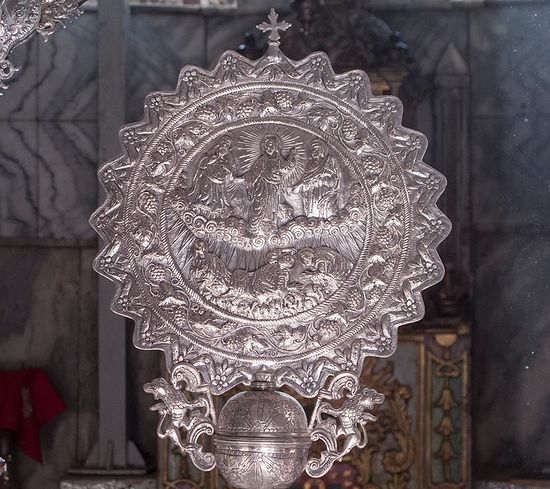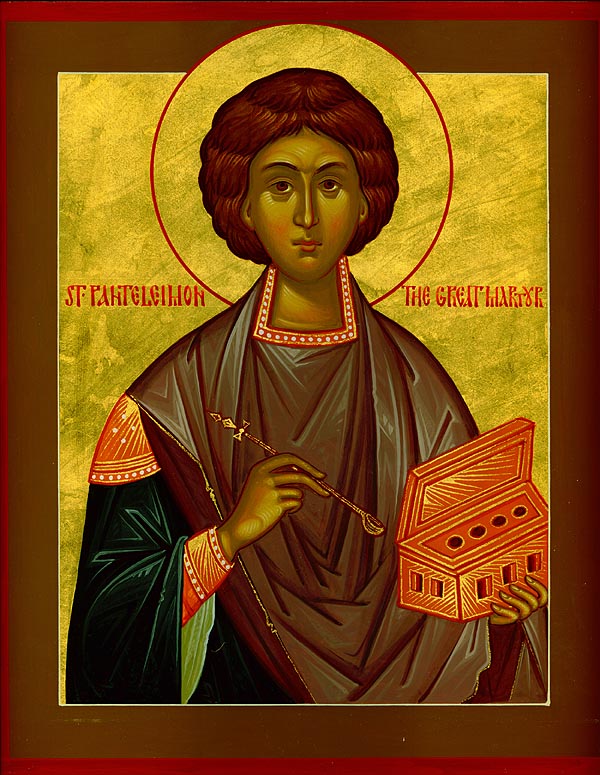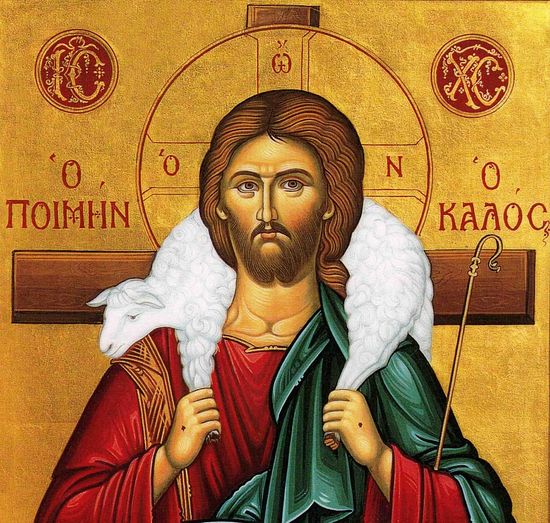 “Jesus goes before us to show us the way, both up the mountain and into heaven.”
“Jesus goes before us to show us the way, both up the mountain and into heaven.”
"And, behold, there talked with him two men, which were Moses and Elias: who appeared in glory, and spake of his decease which he should accomplish at Jerusalem." A ripidion from the altar depicts the Holy Transfiguration to which the Sinai church was dedicated.
At the foot of the God-trodden Mountain of Sinai, Emperor Justinian built the great basilica of St. Catherine's Monastery to the Transfiguration of Christ—the “Feast of monastic feasts.”
 Forty days before He was delivered to an ignominious death for our sins, our Lord revealed to three of His disciples the glory of His Divinity.
Forty days before He was delivered to an ignominious death for our sins, our Lord revealed to three of His disciples the glory of His Divinity.
“And after six days Jesus taketh Peter, James, and John his brother and bringeth them up into a high mountain apart; and was transfigured before them: and His face did shine as the sun, and His raiment was white as the light” (Matt. 17:1-2). This was the event to which our Lord was referring when He said, “There be some standing here which shall not taste of death till they see the Son of man coming in His Kingdom” (Matt. 16:28). By this means the faith of the disciples was strengthened and prepared for the trial of our Lord’s approaching passion and death; and they were able to see in it not mere human suffering, but the entirely voluntary passion of the Son of God.
 The Great Martyr and Healer Panteleimon was born in the city of Nicomedia into the family of the illustrious pagan Eustorgius, and he was named Pantoleon. His mother Saint Euboula (March 30) was a Christian. She wanted to raise her son in the Christian Faith, but she died when the future martyr was just a young child. His father sent Pantoleon to a pagan school, after which the young man studied medicine at Nicomedia under the renowned physician Euphrosynus. Pantoleon came to the attention of the emperor Maximian (284-305), who wished to appoint him as royal physician when he finished his schooling.
The Great Martyr and Healer Panteleimon was born in the city of Nicomedia into the family of the illustrious pagan Eustorgius, and he was named Pantoleon. His mother Saint Euboula (March 30) was a Christian. She wanted to raise her son in the Christian Faith, but she died when the future martyr was just a young child. His father sent Pantoleon to a pagan school, after which the young man studied medicine at Nicomedia under the renowned physician Euphrosynus. Pantoleon came to the attention of the emperor Maximian (284-305), who wished to appoint him as royal physician when he finished his schooling.
The hieromartyrs Hermolaus, Hermippus and Hermocrates, survivors of the massacre of 20,000 Christians in 303 (December 28), were living secretly in Nicomedia at that time. Saint Hermolaus saw Pantoleon time and again when he came to the house where they were hiding. Once, the priest invited the youth to the house and spoke about the Christian Faith. After this Pantoleon visited Saint Hermolaus every day.
 How does the Eastern Orthodox Church view and articulate the atonement of our Lord? This question arises from many converts to the Eastern Orthodox Church, particularly here in America. Many come to the Eastern Orthodox Church looking to leave behind what they may consider harsh or even terrifying notions of God unleashing His wrath upon His Son on the cross. This can become strained when they then come to see the Orthodox Church, through Her fathers and hymnography, employ the same terms and verbiage as their former tradition. So, does the Eastern Orthodox Church thus employ a Penal Substitution model of the atonement?
How does the Eastern Orthodox Church view and articulate the atonement of our Lord? This question arises from many converts to the Eastern Orthodox Church, particularly here in America. Many come to the Eastern Orthodox Church looking to leave behind what they may consider harsh or even terrifying notions of God unleashing His wrath upon His Son on the cross. This can become strained when they then come to see the Orthodox Church, through Her fathers and hymnography, employ the same terms and verbiage as their former tradition. So, does the Eastern Orthodox Church thus employ a Penal Substitution model of the atonement?
 Commemorated on July 17
Commemorated on July 17
The Holy Great Martyr Marina was born in Asia Minor, in the city of Antioch of Pisidia (southern Asia Minor), into the family of a pagan priest. In infancy, she lost her mother, and her father gave her into the care of a nursemaid, who raised Marina in the Orthodox Faith. Upon learning that his daughter had become a Christian, her father disowned her. When she was fifteen years old, St. Marina was arrested and thrown in prison.
Governor Olymbrios was charmed when he saw the beautiful girl, and tried to persuade her to renounce the Christian Faith and become his wife. But Marina refused his offers. The governor became angry and ordered that Marina be tortured. She was fiercely beaten, then fastened to a board and her body torn with hooks. The governor hid his face, unable to witness her suffering. However, Marina refused to yield. Thrown again into prison, an angel appeared and healed her wounds. The next day, she was stripped and tied to a tree, then burned. Barely alive, she prayed: “Lord, You have granted me to go through fire for Your Name, grant me also to go through the water of holy Baptism.”
 Born in village of Kornet, Ljesani County, in Montenegro, on November 2, 1889, to pious parents Petar and Jela Uskokovic, he was baptized in his village church dedicated to St. George and received his baptismal name Ivan.
Born in village of Kornet, Ljesani County, in Montenegro, on November 2, 1889, to pious parents Petar and Jela Uskokovic, he was baptized in his village church dedicated to St. George and received his baptismal name Ivan.
His mother was from the well-known Bozovic family. Both of his parents were well respected in their community holding the office of leadership and particularly his father was a captain of their clan.
 “Jesus goes before us to show us the way, both up the mountain and into heaven.”
“Jesus goes before us to show us the way, both up the mountain and into heaven.”

 The Great Martyr and Healer Panteleimon was born in the city of Nicomedia into the family of the illustrious pagan Eustorgius, and he was named Pantoleon. His mother Saint Euboula (March 30) was a Christian. She wanted to raise her son in the Christian Faith, but she died when the future martyr was just a young child. His father sent Pantoleon to a pagan school, after which the young man studied medicine at Nicomedia under the renowned physician Euphrosynus. Pantoleon came to the attention of the emperor Maximian (284-305), who wished to appoint him as royal physician when he finished his schooling.
The Great Martyr and Healer Panteleimon was born in the city of Nicomedia into the family of the illustrious pagan Eustorgius, and he was named Pantoleon. His mother Saint Euboula (March 30) was a Christian. She wanted to raise her son in the Christian Faith, but she died when the future martyr was just a young child. His father sent Pantoleon to a pagan school, after which the young man studied medicine at Nicomedia under the renowned physician Euphrosynus. Pantoleon came to the attention of the emperor Maximian (284-305), who wished to appoint him as royal physician when he finished his schooling. How does the Eastern Orthodox Church view and articulate the
How does the Eastern Orthodox Church view and articulate the 
